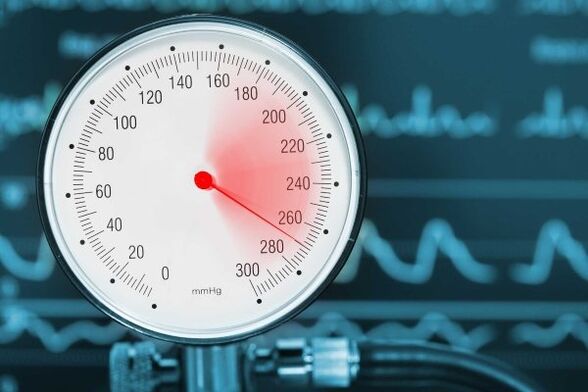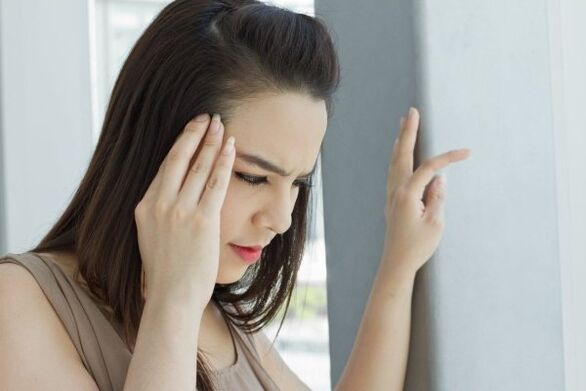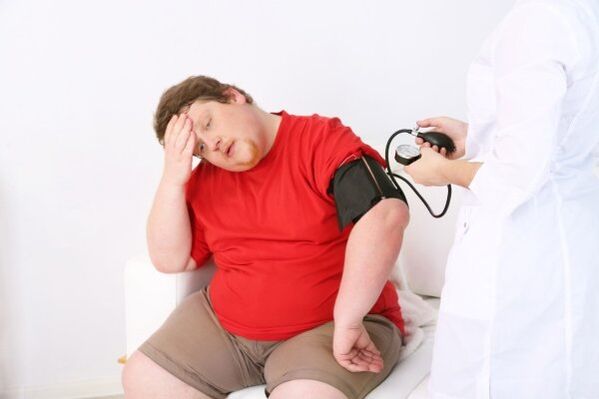Hypertension is a disease associated with periodic or constant elevation of blood pressure (blood pressure).For some, increased stress is the norm, but this is an exception to the rules, and the metrics mentioned by most people are pathological.
Causes and mechanisms of the development of hypertension
In healthy people, the stress is normal to about 120/80 mm.Art.At physiological and chemical levels, increased stress is the body’s natural response to any danger or stress.In critical situations, adrenaline is dripped into the bloodstream, the heart begins to work faster, blood vessels are narrowed, muscles are contracted, and pressure is increased.

Regular stress, experience, lack of sleep, problems - all of which can lead to long-term increase in stress.However, doctors also call it other causes of hypertension: genetics, overweight or obesity, diseases in the thyroid, kidneys, magnesium deficiency in the body, taking some medications.
The pathogenesis of hypertension has not been fully elucidated.The hemodynamic basis of elevated blood pressure is due to the increase in arterial tone caused by nerve pulses caused by the central nervous system along the sympathetic pathway.
In addition to the neurogenesis mechanism, other mechanisms that increase blood pressure (especially bodily fluids) can be opened (sequentially).
Renal factors associated with acute ischemia are also important.The inclusion of renal factors contributes to the development of hypertension and stable blood pressure.A well-known role in the complex pathogenic mechanism of hypertension is exerted by hormones in the adrenal cortex.
Therefore, two groups of factors can be distinguished in the mechanism of increasing blood pressure in hypertension: neurogenicity directly affects arterioles and body fluids through the sympathetic nervous system, and is related to the secretion of amines in children, as well as some other biologically active substances, thus causing an urgent effect.
The mechanism of hypertension development is complex.It is involved in many organs and systems.Therefore, the degree of damage to hypertension by various organs may be unequal, so there are several clinical and anatomical variants of hypertension: damage to blood vessels in the kidneys, heart, and brain.
symptom
Arterial pressure is blood pressure, which depends on the constant impact of the heart that performs its pump function.It offers approximately 70-90 abbreviations per minute.By measuring blood pressure, we considered two numbers: systolic blood pressure (when myocardial contraction) and diastolic blood pressure (when relaxed).Arterial hypertension is often called pressure rise, which is higher than 140 by 90, respectively.
As the pressure increases, many of these characteristics are often observed:
- Headache, noise in the ears;
- Visual impairment;
- Dizziness;
- Absent - Thoughts;
- Memory deteriorates;
- drowsiness;
- Blood pressure is unstable;
- nausea;
- Chills;
- Swelling of eyelids, swollen face in the morning;
- Heart beats;
- chills, sweats, and pulsation on the head;
- Redness on the face, internal tension, anxiety, irritability;
- Performance degradation;
- Swelling of limbs and numb fingers;
- Heart pain.
If any of these symptoms are observed from time to time, it is not proven to be an increase in stress.However, if you notice the long-term presence of signs, consult your doctor.
The most common sign that indicates the disease is headache.The second most important symptom of increased stress is the problem of visual perception:
- Swinging in your eyes;
- The subject is undoubtedly;
- Reduce peripheral vision;
- blindness;
- The fog before my eyes;
- Reduce response to light.

Hypertension and Hypertension: What is the difference?
Hypertension is a chronic disease, prolonged hypertension, which is a continuous increase in blood pressure (i.e., not diagnosis, but physical condition).In fact, these terms are the same, with only the first one indicating the name of the disease and the second indicating the fact that blood pressure is elevated.
High blood pressure and high blood pressure are the current characteristics.Although hypertension is an independent disease, arterial hypertension is a symptom of a pathological state, which itself manifests itself in the continuous increase in stress.
Therefore, it is possible to say that this is the same only in the case of a hypertension crisis.The crisis itself is characterized by a steady increase in stress (hypertension) while occurring due to hypertension.
Hypertension stage
For doctors who have a correct diagnosis, it is necessary to determine the patient's stage of hypertension and make appropriate records in their medical card.If hypertension is diagnosed in the patient at an advanced stage, i.e., in the second or third stage, the patient's physical consequences will be more severe than the first stage of hypertension treatment.However, patients with high blood pressure at the initial stage rarely turn to their doctor, or at least measure their blood pressure regularly.
Phase 1
140-150/90 mm Hg.Art.When arterial pressure fluctuates within these limits, the patient is diagnosed with the first (mild) degree of hypertension.Hypersonic crises rarely occur, and this disease is not a minor.
Phase 2
160-170/100-109 mm Hg.Art.- Second (moderate) degree of hypertension.A hyperosmotic crisis is typical.stenosis of retinal artery and hypertrophy of the left ventricle.
Stage 3
200-300/129 mm Hg.Art.and above.Severe hypertension crises often occur (very severe form of hypertension).The damage effect can lead to hypertensive encephalopathy, LEVO-ventricular deficiency, development of cerebrovascular, hemorrhoids and edema of the optic nerve, renal failure, and renal failure.
Why is hypertension dangerous?
Doctors believe that the consequences of hypertension are more than AIDS, cancer and tuberculosis combined.The insidiousness of this disease is that its symptoms are similar to signs of general fatigue.Therefore, in difficult cases, about half of the hypertension about their disease will learn to be too late and it is almost impossible to stop the body destruction process of its launch.
The danger of hypertension is that it initially violates the function of regulating blood pressure, but in the future it will lead to many serious internal organ and systemic diseases, especially cardiovascular diseases.High blood pressure without medical control can lead to heart attacks, increased heartbeat and ultimately heart failure.
The consequences of hypertension are particularly dangerous for those harmful factors that have an increased killing effect on blood pressure, smoking, drinking, unhealthy nutrition, a sedentary lifestyle, frequent stress, high levels of cholesterol and diabetes in the body.Such people increase the risk of heart attacks, strokes and renal failure, blindness and various cognitive impairments - memory loss, intelligence and performance.

Hypertension is the killer number one among all cardiovascular diseases.In the past 25 years, the mortality rate has increased from 98 to 107.This is a significant increase.50% of patients are treated very effectively, but only 10% reach the target level of blood pressure, i.e. below 130 x 80.
Which doctor is receiving treatment?
As the pressure increases, you should go to an expert.The therapist conducted a preliminary examination of the patient, received the necessary examinations, and determined the doctor who wanted further.This function is explained by the therapist being an expert in several medical fields at the same time.
After completing the preliminary examination, the doctor referred the question to other experts:
- Neurologist;
- cardiologist;
- nephrologist;
- Okulist;
- Endocrinologist.
diagnosis
The easiest way to diagnose is to measure blood pressure.If stable increases to 140/90 mm Hg.Art.Above, this means there is high blood pressure.
The increased pressure was considered stable during repeated measurements (at least 2-3 times on different days of 4 weeks).
The following diagnostic methods are also used to determine the presence of hypertension:
- Urine analysis of protein and glucose;
- on hemoglobin or hematocrit;
- Determine creatinine levels or increase in nitrogen in blood and urine;
- glucose levels during hunger;
- electrocardiogram;
- Heart ultrasound, kidney;
- Consult an optometrist by studying blood vessels under the blood.
Blood pressure measurement
Blood pressure measurement using manual inclination measurement (Korotkov method):
- The Tonometer cuff should be at the heart level 2 cm above the elbow (middle chest).The fingers should be passed between the cuff and the hand.The cuffs should cover at least 80% of the shoulder colloid, accounting for at least 40% of its length.
- Place the speech mask on the shoulder artery pulsation point.
- Quickly pump air into the cuff with pear (don't forget to close the valve early) so that the air does not return to the upper pressure level of 20 mm Hg.Art.Exceeding the systolic period (according to the disappearance of the pulse).
- Release air slowly from the cuff at a rate of 2 mmHg.Art.In the second part.The value heard by the first strike corresponds to the upward pressure.The level of pitch stop corresponds to a lower pressure.If the tone is very weak, you should raise your hand, bend and straighten a few times, and then repeat the measurement.
Blood and urine tests
General blood tests or urine tests for hypertension do not provide information.It is impossible to determine the cause of the disease through such indicators, but they help to identify the stage of the disease.
From a general blood test, you can understand the quantity of forms and evaluate the presence of inflammatory processes in the body.

Evaluate the work of the heart
There are several ways to evaluate heart work:
- Physical diagnosis involves the study of myocardium examination with the help of voice-scope.Doctors "listen" to the heart, revealing noise, rhythm disorders.According to the results of physical diagnosis, ECG was prescribed.
- Electrocardiogram (ECG) is also an assessment of the work of the myocardium, only in more detail.Such research allows you to determine possible changes in time and fully analyze the work of your heart within a certain period of time.
- Multiple placement is an effective ultrasound examination that helps determine the condition of blood passing through the blood vessels.
- Angiography is a radiological method for evaluating the condition of the arterial wall, revealing aneurysm plaques, arterial defects.
Examination at the bottom of the eye
Therefore, the eyes are considered as target organs with high blood pressure, so pay attention to ifalmodist when diagnosing increased stress.Usually, in the initial stage, the stenosis of the retinal veins and arteries is expanding.These functional changes are reversible: as the pressure normalizes, the blood vessels also return to normal.
In the second stage, organic changes occur and the situation worsens.Microscopic fever appears and bleeding may occur.
In the third stage, the optic nerve changes, the visual field deteriorates, and the visual function is destroyed.
ultrasound
The kidneys were evaluated through ultrasound examination of the kidneys and adrenal glands.Due to the increased pressure on the organs, the nephrons filter blood cells of the toxin blood every day.Finally, this can lead to renal failure.
Ultrasound of the kidney helps identify volumetric strata in severe lesions of the adrenal glands, kidney tissue.Ultrasound examination of renal artery is also specified.
How to treat hypertension?
Non-drug methods:
- Lose weight to normal;
- Refuse to smoke;
- Reduction of alcoholic beverages;
- Moderate physical exercise (walking regularly in fresh air);
- Reduce salt consumption;
- Increased diets for plant foods rich in calcium, magnesium and potassium;
- Reduce animal fat consumption.
If the non-valley method is ineffective, medication should be prescribed, or the patient has risk factors for diabetes, hypertension crisis, kidney damage and coronary atherosclerosis.
poison
The development of hypertensive drugs has been going on for more than a decade.But today, the problem of new, more effective, safer methods for reducing and controlling stress remains a sharp rise in medicine and pharmacology.
Today, the drug has the largest range of types, but all of these drugs have different exposure types, efficiency, indications, and contraindications.Their costs play an important role.Therefore, for each patient, the doctor mainly chooses a separate drug treatment regimen based on the reasons for its occurrence:
- Diuretic.These drugs partially block calcium channels and have a vasodilatory effect.They are recommended if vascular diseases are present with hypertension, but this method is contraindicated for people with myocardial infarction.
- ACE inhibitor (Angiotenzinzinzinopring enzyme).Reduce the production of enzymes that stimulate reduced vascular elasticity.They are very effective, tolerated by patients with hypertension, and are beneficial to the cardiovascular system.It is often recommended to increase stress after myocardial infarction and in the context of diabetes.
- beta-adrenaline.Lower heart rate and lower strength.They are widely used and are recommended for angina and tachycardia after a heart attack.
- Emergency pressure decompression drugs.This includes extracts from Mother Ut, Valerian, Peony roots.
diet
A special product for high blood pressure is baked potatoes.This product is rich in potassium, the most important trace element that regulates water and salt metabolism in the body.
The main nutrients of hypertension are potassium, calcium, and magnesium.It is these trace elements that greatly reduce blood pressure.
A high blood pressure diet means rejecting fast foods, which usually contain sodium, helping to increase stress.In addition, the diet should be saturated and contains calcium and magnesium products:
- Cereals - bread, rice, solid varieties of wheat;
- Dried fruits and thin vegetables;
- low fat and poultry;
- Low-fat dairy products;
- Nuts and beans.
Be cautious about fatty foods and candies.
Doctors claim that following a diet helps maintain stress within the normal range, reducing the risk of stroke by nearly 40% and heart attacks by 30%.
Life
All patients with blood pressure indicators were above 120-130 x 80-64 mm Hg.Art.You need to urgently change the lifestyle and nutrition they are familiar with.This includes limiting smoking and drinking, properly compiling a complete diet, and physical exercise.
Like any chronic disease, a healthy hypertensive lifestyle is one of the main factors in effective treatment.Therefore, changes are considered a key step in the treatment process and prevention of arterial hypertension.
Folk therapy
Most people with high blood pressure take special medications, but you can also fight the disease with well-known folk remedies.Consider some effective recipes:
- Flax seeds.They contain a large amount of fatty acids in the Omega-3 group.They help increase lipoprotein levels with increased blood density, which prevents increased cholesterol and the formation of complications of atherosclerosis on the wall of blood vessels.The human body itself cannot integrate this substance, so it must be ensured that food is brought.In flax seeds, the amount of omega-3 is 25% by weight, and they are relatively cheap and well absorbed.Take 3 tablespoons of flax seeds daily in chopped form.
- tin agent for red pine cone.Helps normalize blood pressure and adjust the posterior state.The tin agent is prepared like this:
- In summer, collect raw materials, rinse under tap water and pour into jars;
- Lost vodka or 40 degrees alcohol and place it in a dark place;
- Keep it at room temperature for 2-3 weeks;
- Before you start taking it, filter through gauze and double it.
- The correct preparation of tin agent should be dark red.Half an hour before a teaspoon meal, it takes 3 times a day.You can mix it with water or tea.
- garlic.If you take garlic regularly, this will stimulate blood flow in the blood vessels, preventing it from oxidizing hair loss and degrading the deposition on the wall.The near-eye hype properties of garlic help prevent blood clots.Continuous use of garlic cloves can help lower blood pressure by 7-8%.
- Two garlic teeth are chopped and poured into a cup of boiling water;
- Let it brew for 12 hours;
- In the morning, drink and prepare a new injection.
- The course is one month.Take one cup twice a day.
- Lemon and cranberries and honey.Toast lemons and mix the spoon with a spoonful of cranberries.Add a tablespoon of ground fresh rose hips, a cup of honey, and grab a tablespoon in the morning and evening.
- banana.Take 4 tablespoons of crushed plantain leaves.Pour a glass of vodka and let the composition brew in a dark place for two weeks.Filter the mixture and use 30 times a day 30 times.

You can also cook garlic infusion:
forecast
In the absolute recovery sense, the prognosis of hypertension is usually unfavorable.The further development of the disease is completely stopped only in the transistor stage.However, modern treatments allow you to slow the progression of the disease, prevent the development of complications, relieve the patient's condition and maintain their ability to work for a long time.
The prediction of renal variants in this course is very unfavorable, especially when renal atherosclerosis develops.At any stage of hypertension, the recovery of atherosclerosis worsens.
Measures to prevent hypertension
Prevention of hypertension is divided into primary and secondary.Primary prevention requires health – people who have not yet stressed more than normal.The following healing complexes not only help keep stress normal, but also get rid of excessive weight and significantly improve overall health:
- Low-salt diet;
- animal fat limitations;
- exercise;
- Psychological uninstallation;
- Reject bad habits;
- Weight control.
Secondary measures aim to maintain blood pressure in patients with hypertension, rule out hypertension crises, and prevent disease complications.Secondary Prevention - Including psychological training that contributes to moral and emotional offloading, physical therapy procedures, nursing home treatment, the use of sedatives that improve sleep, the use of traditional medicine (Hawthorne, Peony, Peony, Valerian, mother) and control of daily stress indicators.
If you pay attention to high blood pressure in time and start treating it, serious consequences can be avoided.Stress problems are not only solved by medication, but are solved to a greater extent due to health, the right way of life and control over health.






















